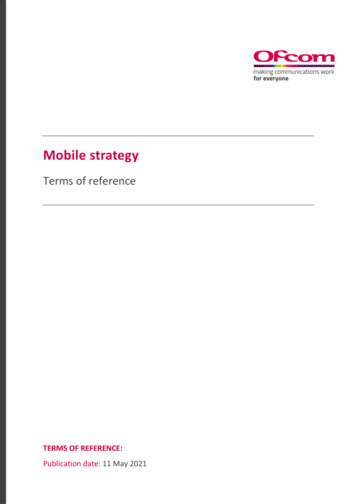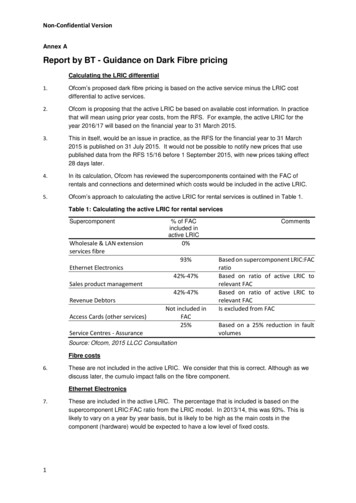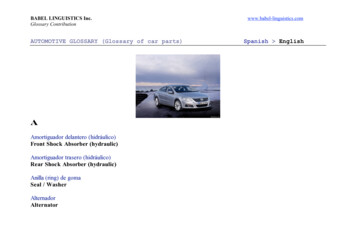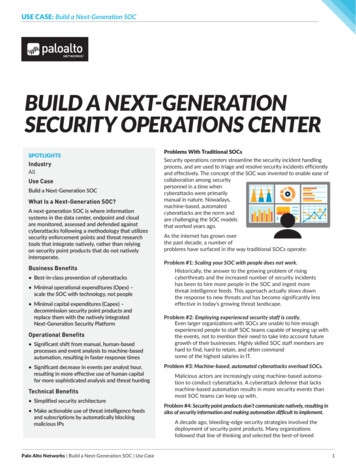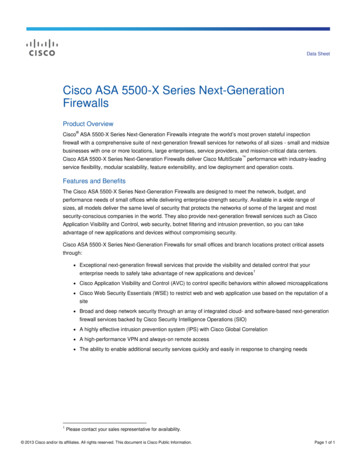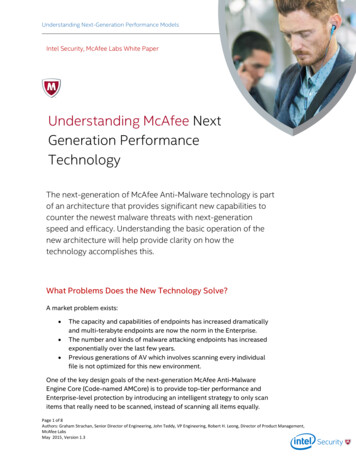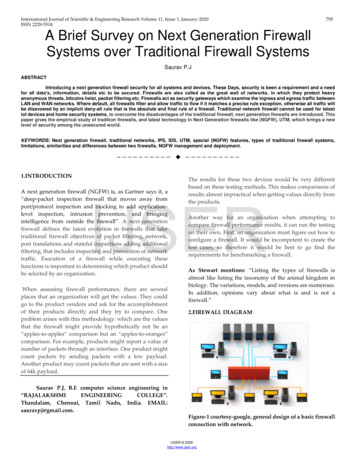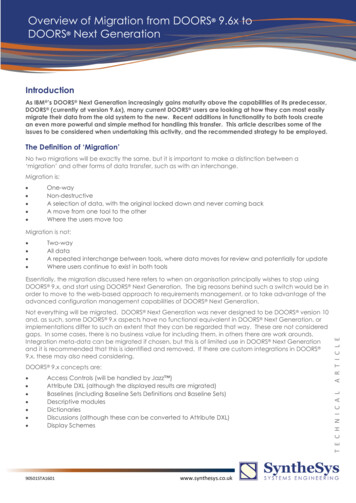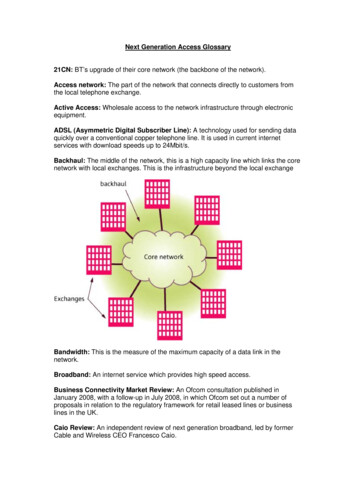
Transcription
Next Generation Access Glossary21CN: BT’s upgrade of their core network (the backbone of the network).Access network: The part of the network that connects directly to customers fromthe local telephone exchange.Active Access: Wholesale access to the network infrastructure through electronicequipment.ADSL (Asymmetric Digital Subscriber Line): A technology used for sending dataquickly over a conventional copper telephone line. It is used in current internetservices with download speeds up to 24Mbit/s.Backhaul: The middle of the network, this is a high capacity line which links the corenetwork with local exchanges. This is the infrastructure beyond the local exchangeBandwidth: This is the measure of the maximum capacity of a data link in thenetwork.Broadband: An internet service which provides high speed access.Business Connectivity Market Review: An Ofcom consultation published inJanuary 2008, with a follow-up in July 2008, in which Ofcom set out a number ofproposals in relation to the regulatory framework for retail leased lines or businesslines in the UK.Caio Review: An independent review of next generation broadband, led by formerCable and Wireless CEO Francesco Caio.
Communications Providers (CPs): Companies which provide services to acustomer’s home, such as telephone and internet services, and which usually ownsome infrastructure.Core Network: The backbone of a communications network, which carries differentservices such as voice or data.DOCSIS 3 standard - Data Over Cable Service Interface Specification: Theinternational standards for sending data over a cable network.Ducts: Existing trenches and pipes which hold copper and fibre lines.Duct Access: When the owners of ducts and trenches let other service providerspay to access them.Downstream/upstream competition and products: Describes the relativepositions of different players, or their products, in the supply of broadband. The most‘upstream’ provider is the one that sells the most basic product (for example copperor fibre access). Players who are ‘downstream’ of this are those that buy this basicproduct, add their own elements (for example their own electronic equipment to theend of copper links). These are often called wholesale providers. Further‘downstream’ still are players who buy these ‘wholesale’ products, add their ownbranding, billing and customer services, and sell them on to customers. In practice,one company may do all three stages above, either explicitly or implicitly (forexample Virgin Media or BT).ERG: European Regulators Group of which Ofcom is a member.Ethernet: A common technology which allows computers on a network to talk toeach other.Exchange: A building which houses electronic equipment that connects telephonecalls. Backhaul links from a content provider are terminated here to connect accesslinks to end users.Gigabit Passive Optical Network (GPON): A shared fibre network architecture thatcan be used for next generation access.Fibre-to-the-cabinet (FTTC): An access network structure in which the optical fibreextends from the exchange to the cabinet. The street cabinet is usually located only afew hundred metres from the subscriber’s premises. The remaining part of theaccess network from the cabinet to the customer is usually copper wire but could useanother technology, such as wireless.Fibre-to-the-home (FTTH): An access network structure in which the optical fibreruns from the local exchange to the end user's living or office space.
Integrated Services Digital Network (ISDN): A network which allows the digitaltransmission of voice and data over traditional copper lines.Local Loop Unbundling: When communication providers can gain access to thenetwork by placing their own equipment at the exchange. The communicationproviders then gain control of the line from the local exchange to the customer andthe backhaul runs from the local exchange to their core network.Narrowband: A service which provides internet data speeds up to 128 kilobits persecond otherwise known as dial up. This is most commonly used for making phonecalls over a copper wire.Network neutrality: A way of processing data which does not differentiate betweendifferent bits of data when it moves through the network, so that all traffic (e.g. voicecalls, web browsing, gaming etc) is treated equally.Next Generation Access (NGA): New or upgraded access networks that will allowsubstantial improvements in broadband speeds and quality of service compared totoday’s services. Can be based on a number of technologies including cable, fixedwireless and mobile. Most often used to refer to networks using fibre optictechnology.
Next Generation Networks (NGN): An upgrade to the core or “backbone” part of thenetwork.Not-spots: Areas where there is not sufficient broadband access.NRAs: National Regulatory Authorities, such as Ofcom in the UK.Openreach Financial Framework: An Ofcom consultation document published inMay 2008 which reviews the prices that Openreach can charge othercommunications providers for its wholesale access telecoms services.Passive Access: Wholesale access products based on direct access to the physicalinfrastructure of the network, without the need to connect to electronic equipment.Regional Development Agencies (RDAs): Public bodies which aid regionaldevelopment in English Government Office regions.Service providers (SPs): Companies which provide services, such as telephone orinternet services, to a customer’s home or business.Splitter: A piece of equipment used in fibre optic technology which splits a beam oflight into many optical signals.Street cabinet: A green box close to your house that connects your telephone line tothe exchange.Sub-loop unbundling: Like local loop unbundling (LLU), except that serviceproviders interconnect at a point between the exchange and the end user, usually atthe cabinet.
Traffic shaping: When certain types of packets are given priority as they passthrough the network. This is the opposite of net neutrality.Universal Service Obligation (USO): BT, along with KCom in Hull, has a duty toprovide a basic telephone and narrowband (or dial up) internet service to everyone inthe United Kingdom.Upstream/downstream competition and products: Describes the relativepositions of different players, or their products, in the supply of broadband. The most‘upstream’ provider is the one that sells the most basic product (for example copperor fibre access). Players who are ‘downstream’ of this are those that buy this basicproduct, add their own elements (for example their own electronic equipment to theend of copper links). These are often called wholesale providers. Further‘downstream’ still are players who buy these ‘wholesale’ products, add their ownbranding, billing and customer services, and sell them on to customers. In practice,one company may do all three stages above, either explicitly or implicitly (forexample Virgin Media or BT).VDSL (Very high bitrate DSL): An upgrade to ADSL technology which allows forvery fast internet access over copper lines. It is likely to be the technology which willbe used in FTTC deployments.WiFi: Short range wireless technologies that allow an over-the-air connectionbetween a wireless device and a base station, or between two wireless devices. WiFihas a range of over 30 metres indoors, and around a kilometre outside.WiMax (the Worldwide Interoperability for Microwave access): A wirelesstechnology, similar to WiFi, but with a longer range which can cover many kilometres.WiMax has been considered as a wireless alternative for an access technology toprovide high speed access links instead of using copper to properties.
Next Generation Access Glossary 21CN: BT's upgrade of their core network (the backbone of the network). Access network: The part of the network that connects directly to customers from the local telephone exchange. Active Access: Wholesale access to the network infrastructure through electronic equipment. ADSL (Asymmetric Digital Subscriber Line): A technology used for sending data
